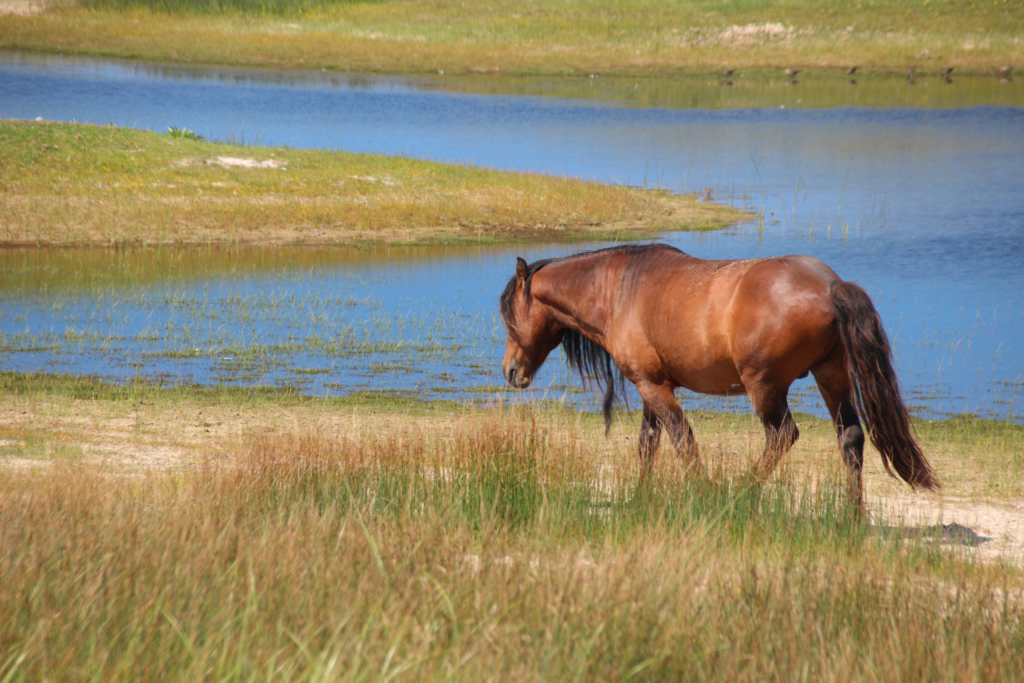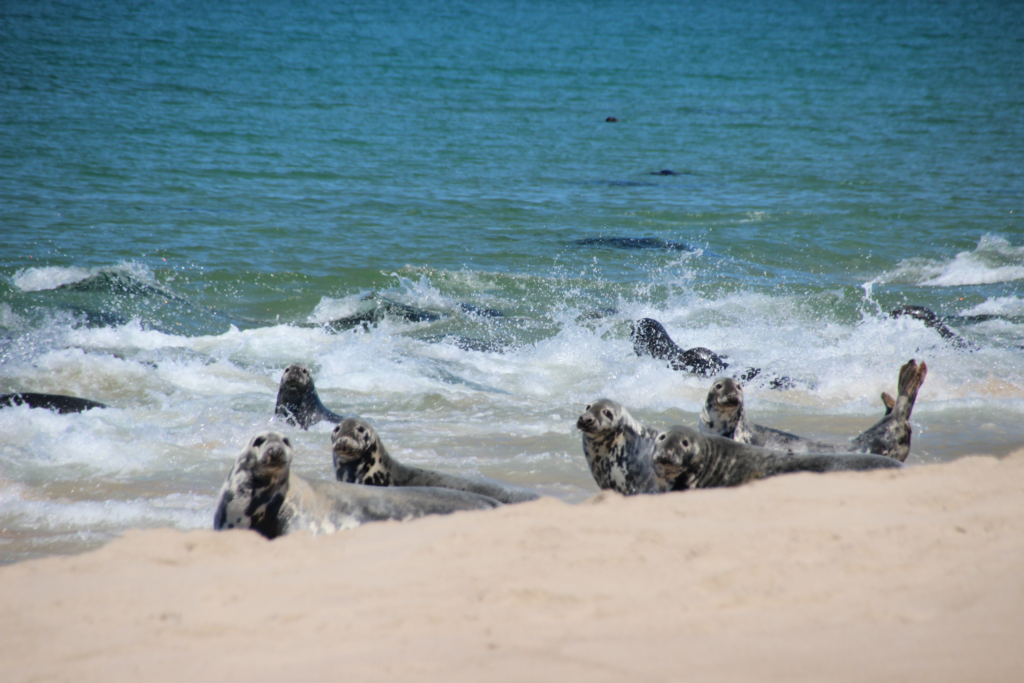A protected North Atlantic reserve teeming with wildlife offers conservation lessons that may benefit us all.
After flying over the North Atlantic for an hour, we finally spot Sable Island. It’s 180 miles (290 kilometers) from the nearest airport — in Halifax, the capital of Nova Scotia on Canada’s eastern coast. Sable is a narrow, treeless crescent of sand perched in shallow waters at the edge of the continental shelf, a twenty-seven-mile long green-and-gold thread afloat on the rippling fabric of the ocean.

When one of the other six passengers asks through the headset if the torpedo shape silhouetted against the sandy ocean bottom beneath us is a shark, Fred Stillman, the owner of Kattuk Expeditions, says, “It’s one of eighteen species found in these waters.” Stillman guides over 400 visitors to the island each year by helicopter and small plane. Kattuk is one of just six licensed companies permitted to guide visitors to the island. Throughout this particular Kattuk trip, Stillman exhibits deep knowledge and respect for Sable.
Before boarding, he sterilized our shoes to kill pathogens such as Streptococcus equi, which can cause a lethal bacterial infection known as “strangles” in horses. Such care is vitally important to the health of the island’s 500 wild horses. A herd has survived here for nearly 300 years, foraging on marram grass, beach pea, and other native plants. The horses are just one reason Canada granted this uninhabited island National Park Reserve (NPR) status in 2013.
Canada's National Parks System
Canada’s park system is continuing to expand and now comprises thirty-seven national parks, one urban national park, and ten park reserves totalling 129,863 square miles, an area the size of Germany. Still, the country has a long way to go to meet its ambitious target of protecting twenty-five percent of the country’s land by 2025 and thirty percent by 2030. As of 2023, it’s just half way there. Ten new parks are in the works in an effort to reach the 2025 goal.
The government considers a wide range of factors when selecting lands for protection under the National Parks Act. While there’s no formula for establishing new parks, proposed sites must meet key criteria: Is the landscape already represented in another park? Would it protect biodiversity? Does it have cultural significance? Does it have the support of Indigenous communities and various levels of government? During the assessment process, while participants negotiate agreements, the land is temporarily protected.
The Goodall of Sable
Our first stop on the island is a shallow pond where we count thirty horses nearby. As they drink, play, and rest, Stillman tells us about a four-year, ongoing study called “Fences in the Sand,” designed to determine the impact horses have on the island ecosystem. Parks Canada and the non-profit Sable Island Institute set up nine fenced exclosures of about one hectare each and three small pond exclosures to compare areas free of horses to the rest of the island.
As we approach the main station — a half-dozen Parks Canada buildings and the only sign of humans — we’re dive-bombed by scouts from the nearby colony of 5,000 terns. Ducking and running, we reach the station unscathed. There, we meet Zoe Lucas. Lucas is to Sable as Jane Goodall is to Tanzania. She’s been coming to the island every year for half a century to conduct research, much of that time with the Nova Scotia Museum of Natural History.
We follow Lucas to one of the horse exclosures where she summarizes the questions posed by researchers. “Are the horses providing fertilizer versus eating too much of the grass? Are they having an impact on water?”
Another ongoing study by researchers from Dalhousie University in Halifax is analyzing the impacts of dune erosion and salt water contamination of the island’s fresh water supply, vital to the horses’ survival. Rain filters through the sand into natural aquifers that supply the shallow ponds, but recent hurricanes have swept away protective dunes, putting the ponds in jeopardy.
We follow Lucas onto the beach. It stretches to the horizon. Hundreds of seals are sunbathing on the dry sand. Spotting us, they tumble into the surf, their heads polka-dotting the sea. It’s a remarkable sight; just fifty years ago, hunting, bounties, and culls reduced seal numbers to a few thousand. Today, over 400,000 gray seals breed on Sable Island — some 75,000 pups are weaned each January — making it the world’s largest herd and one of the greatest wildlife recovery stories on the planet. Seals are now so numerous that they’re difficult to count, so Parks Canada has partnered with Zooniverse, a digital platform that rallies a community of citizen scientists (if you want to get involved, another study is slated for 2025). Students and others zoomed in on 917 aerial photos taken on a single day of the entire coastline and counted the seals in each shot, completing the count by November 2023.
Sable itself is the subject of much study, but because of its remote location in the Gulf Stream, it’s also the base for research on a global scale. In one ongoing study, researchers with the Sable Island Institute collect and analyze trash that washes up on island beaches to determine the most common brand names of ocean pollution. (Drink containers from Big 8 Beverages, owned by Sobey’s — a Nova Scotia company and Canada’s second largest grocery chain — have made up 25 percent of beach trash to date. Gatorade and Pepsi by PepsiCo and Powerade by Coca-Cola have so far placed second and third in the audit.)

Returning to the station, Lucas points out a tiny, cubical building. “That’s a geomagnetic observatory,” she says. “It’s part of an international network around the planet, measuring the Earth’s magnetic field.” Such measurements help standardize measuring and recording equipment. Lucas says it’s forbidden to approach the structure with anything made of iron. “It’ll throw off the readings. The whole thing is built with [non-magnetic] brass screws.”
Thanking Lucas for her time, we head back to the helicopter pad where Stillman has one last surprise for us. He produces a bottle of bubbly, pops the top, and pours eight glasses. We toast our northern safari in one of the world’s greatest and least known wildlife reserves.
What is a National Park Reserve anyway?
In Canada, a park reserve is a precursor to a national park. The Canada National Parks Act governs which lands are designated national parks and which are national park reserves (NPR). Management of both is virtually the same, except that a reserve is subject to Indigenous land claims. In reserves, Indigenous people continue their traditions of hunting, fishing, and trapping. Once a land claim is resolved, boundaries and conditions of use are finalized. The land then becomes a national park. With the approval of the Mi'kmaq — the Indigenous people of eastern Canada — Sable Island became an NPR on June 20, 2013, protecting it and nearby waters from pressures such as drilling for oil or gas. At the time, the Mi’kmaq created a pledge meant for all future visitors. Parts of the pledge sound familiar — tread lightly and leave no trace. Other parts arise from the Mi’kmaq relationship with the island that goes back millennia: Recognize that the island has its own life force sacred to the Mi’kmaq. Honor the land and msit no’kmaq, a core Indigenous philosophy that understands all life as interconnected. No timeline is set for Sable Island to become a national park.
Six Ways to Get to Sable Island
These six operators are licensed by Parks Canada:
- Hurtigruten Expeditions operates a small cruise ship that runs between Halifax and Boston with a stop at Sable Island.
- Kattuk Expeditions, Fred Stillman’s company, is the most experienced guiding outfit for expeditions to Sable Island.
- Picture Perfect Tours departs by helicopter from Halifax’s international airport for day trips to Sable Island.
- Sable Aviation departs by twin engine plane from Halifax’s international airport and lands on hard sand at Sable Island where Parks Canada offers a short guided tour.
- Silversea is a larger cruise ship company that sometimes includes a stop at Sable Island on some itineraries.
- Vision Air Services provides helicopter services for many purposes, one of which is transport from Halifax’s international airport to Sable Island. Both Kattuk and Picture Perfect use Vision for transport to the island.






